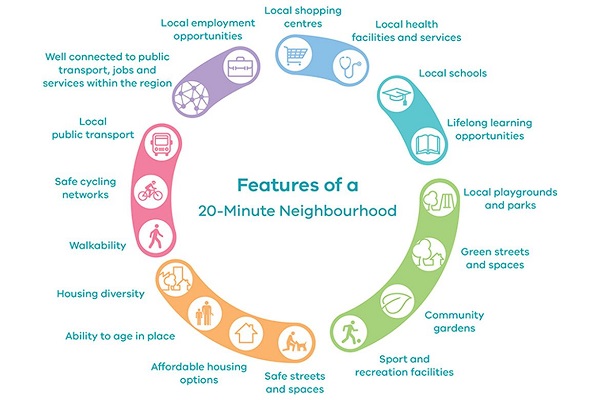The RTPI aims to promote a wide variety of views in its blog section. The views expressed by authors are their own and do not necessarily reflect the views of the RTPI.
 Creating places for people, supporting communities to shape where they live, and planning for the green economy: Scottish Government aspirations, but also close to planners’ hearts. That is why they are at the heart of RTPI Scotland’s 2021 manifesto.
Creating places for people, supporting communities to shape where they live, and planning for the green economy: Scottish Government aspirations, but also close to planners’ hearts. That is why they are at the heart of RTPI Scotland’s 2021 manifesto.
Turning these lofty aspirations into reality is what gets me, as a planner, up in the morning. It’s an exciting challenge. We’ve now got two new important tools to help us: the “20-minute neighbourhood” and Local Place Plans.
In reality, neither of these are new concepts.
The 20-minute neighbourhood is a catchy name for ‘walkable neighbourhoods’, a concept that’s become popular across the world from Melbourne to Paris and Portland. It’s an established principle of urban design and planning, which aims to make sure that people’s everyday needs are within easy safe walking distance of their homes: schools, shops, parks, good public transport and so on.
Local community-led planning, the principle at the heart of Local Place Plans, has been around for many years in the form of Community Action Planning.
What’s different and exciting now is that the Scottish Government is giving us stronger tools to turn these lofty aspirations into reality.
The Scottish Government’s 2020-21 Programme for Government announced the ambition of 20- minute neighbourhoods, giving it that all-important stamp of authority. I hope that will be backed up by the funding needed to invest in delivering 20-minute neighbourhoods across Scotland – from making walking a genuinely attractive and comfortable choice in preference to jumping in the car for a five-minute journey, through to the location and design of new health centres and schools.
20-minute neighbourhoods won’t happen overnight. They will take many years of investment to replan our neighbourhoods so that shops, parks and all the other aspects of everyday life exist within a few minutes’ safe and easy walk. Our job as planners is to work with communities, infrastructure providers, the NHS and other public services to make sure that we start now to plan that ‘walkable’ future pattern of education, work and infrastructure – whilst also co-ordinating relatively quick wins that can be delivered in just a few months, like safer, cleaner and more pleasant walking routes to schools and shops.
Local Place Plans, meanwhile, will properly come on to the statute books over the next year or so. They will provide communities and planners with a mechanism to work together to plan and deliver 20-minute neighbourhoods on the ground: communities setting the aspirations, planners helping to work out how to turn them into reality, and everyone collaborating to deliver the goods.
Collaboration is the key word here, and Local Place Plans will be the vital tool for that collaboration. Today’s reality is that making our neighbourhoods the best they can be is neither top-down nor bottom-up, but a meeting of minds. Communities can tap into funding that local authority planners cannot access, have local knowledge, and have or can develop capacity (with the right support) to make things happen. Planners bring the vital links to other departments, agendas and organisations that help to navigate the system and turn community aspirations into reality.
This isn’t pie in the sky. I’ve seen it work with my own eyes at Foxbar in Paisley, for example, on a pilot Local Place Plan prepared by the local community and the local authority. Two years after the plan was prepared, the community aspirations in that plan are now being delivered collaboratively, from quick wins like land for community food growing to longer term ambitions like redeveloping historic vacant sites for the right kind of housing locally. Scotland has lots of other examples of successful, collaborative, community-led planning.
I see 20-minute neighbourhoods and Local Place Plans like two sides of a coin: the former describes what we’re aiming for and gives it national priority, whilst Local Place Plans enable it to be tailored and delivered at the local level. Both are about making our everyday neighbourhoods better and healthier places to live and work, with all our day-to-day needs on tap. That’s good for health and wellbeing, for reducing carbon emissions, for the future of our communities, for post-COVID recovery.
Of course, resources will be needed for communities, planners and everybody else involved to make the most of the potential opportunities that Local Place Plans and 20-minute neighbourhoods, by investing in planning and delivery on the ground. So let’s secure those resources – keeping our eye on the prize of healthier, greener communities across Scotland.
RTPI Scotland published its Manifesto on 26 January 2021.
 Nick Wright
Nick Wright
Nick Wright MRTPI has worked in Scottish planning for 30 years: in local authorities, the voluntary sector and for the last 15 years as an independent practitioner. His interest in community-led planning stems from two years working in Jakarta, Indonesia in the mid 1990s to design and deliver community-led housing. Nick was Convenor of RTPI Scotland in 2016.


